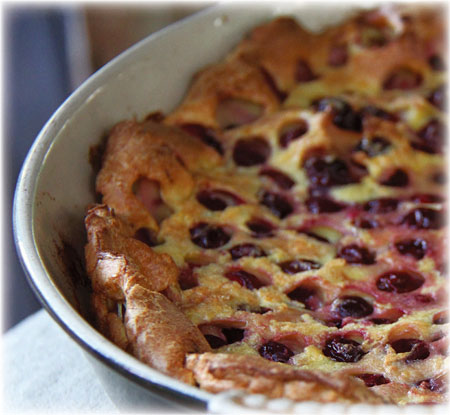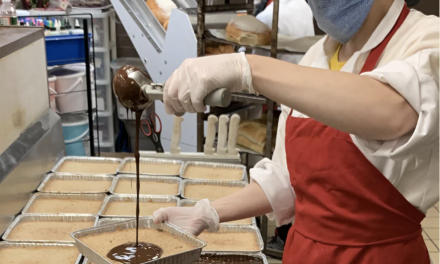
I’ve adapted this recipe from the clafoutis auxcerises published in a 1937 French cookbook, Les MénusDétaillés de la Ménagère.
In our laid-back household, we love to eat beach plums in a rustic, French farm-wife kind of way: baked in clafoutis. The most down-home, provincial French versions of this batter pudding call for pits left in for flavor. Conveniently for those of us who like to take the easy path, leaving the fruit whole does contribute complex flavor and deep color; and it just means that we only serve it among friends. On an autumn evening, there’s nothing quite like savoring a foraged treat, kicking back and spitting pits over the porch rail.
- about a pound of nice ripe beach plums
- 3 large or 4 small eggs
- 1 cup whole milk
- 1 cup unbleached all-purpose flour
- ½ teaspoon salt
- 1 shot of rum or brandy
- 2 tablespoons butter
- ¼-½ cup sugar
 Use a whisk to beat the eggs well, then beat in about half the milk. Add the flour all at once and beat until smooth. Add the remainder of the milk, the salt and the rum or brandy. Beat smooth, then let rest while you do the next steps, for about 20 minutes.
Use a whisk to beat the eggs well, then beat in about half the milk. Add the flour all at once and beat until smooth. Add the remainder of the milk, the salt and the rum or brandy. Beat smooth, then let rest while you do the next steps, for about 20 minutes.
Preheat the oven to 375 degrees F. Rinse, dry and pick over the plums, discarding stems. Find a good-sized gratin dish or oval baker—10-12 inches long is about right. Place the butter in the dish and pop it into the oven, which should be almost hot enough by now.
When the butter is melted and sizzling, pull the dish out of the oven and swirl to coat the sides. Add the batter to the hot dish, sprinkle on the beach plums in an even layer (they’ll sink), and scatter the sugar over. Pop it back into the oven and bake about an hour, or until puffed and golden brown.
Serve hot or warm with a sprinkle more sugar if necessary and lashings of cream as good as you can find. If I’m firing on all burners the night before, I’ll culture some cream with yogurt to make a version of crème fraiche that makes all us yokels extra-happy.
Serves 4–6
Paula Marcoux is a Plymouth food historian and author who reminds you to always get identification help from a trusted source (or a nearby chimp) before sampling wild foods.






